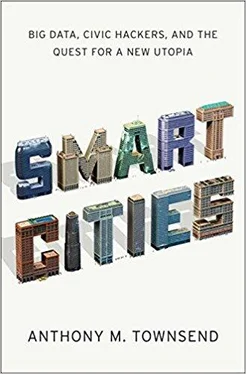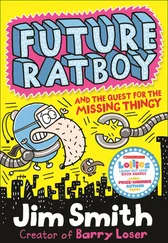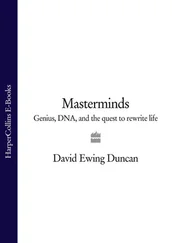Its a tough pitch to resist. For a world that seems increasingly out of kilter, rewiring cities with business technology is a seductive vision of how we can build our way back to balance. As cities struggle to grow while simultaneously improving public services and reducing carbon emissions, something has to give. If a modest investment in smart technology can deliver greater efficiency, it will pay for itself—a rounding error, really, on the staggering infrastructure investments needed.
Nowhere is the need more clear than in our aging, obsolete, and inadequate electric power grid.
Power Platform
We take few things for granted more than the ubiquity of electrical power in modern cities. We are only conscious of its existence when it fails. And while a surprising number of us still avoid the Internet, only a handful of sects shun the many conveniences of electricity. In 2008 the worlds power plants produced 19.1 trillion kilowatt- hours of electricity, and global generating capacity is expected to nearly double by 2035.35 This growth will be driven by urbanization, as businesses in developing countries build new factories and workers spend their newfound wealth on electrical appliances. Huge new sources of demand will also come online as urban infrastructures that have traditionally been powered by fossil fuels shift to electricity. Electric cars and buses will refuel from the power grid instead of gas stations. Geothermal heat pumps, which use the steady temperature of the earths crust to efficiently heat and cool homes and buildings, will replace oil and natural gas-fueled boilers.
The grid will get bigger, but also more complex. Adding renewable sources of energy like solar panels and wind turbines to the grid dramatically increases the need to move electricity around like Internet packets. The sun doesn’t shine evenly and the wind shifts, creating a fickle flow of power that needs to be balanced across regions and over time. Add to that our own variable demands for power and the challenge gets very complicated very quickly.
As you read this book, chances are you are being lit, cooled, or transported by something invented by General Electric or Siemens. Long before Cisco jumped into city building, these companies laid the lines that, to borrow from GEs 1980s marketing campaign, “bring good things to life.” But perhaps GE was too modest. They don’t just bring good things to life. They make modern life possible. The scale of these companies is breathtaking. Both employ hundreds of thousands of people and generate more than $100 billion in annual revenues. But it means they are well matched to the enormous engineering challenge of providing mobility, sanitation, energy, and communications for seven or eight billion middle-class city-dwellers worldwide by this century’s end.
Their first task in this century is to rebuild the electric power grid they built in the last one. Overhauling the power grid is an urgent priority for smart cities because without a stable supply of electricity everything comes to a stop. When a tsunami struck Japan in 2011, triggering the shutdown of most of the nation’s nuclear generators, the multistory digital screens of Tokyo’s Shibuya Crossing—the Asian equivalent of Manhattan’s Times Square—went dark for weeks. Normally crisscrossed by mobile phone-toting “smart mobs,” as author Howard Rheingold dubbed them, it is a place that lives in my memory as the paragon of future urbanism. Tokyo survived its digital lobotomy—there’s still enough of the conventional infrastructure in place to live life manually, so to speak. But in future cities even the most mundane tasks will draw upon sensors, computers, and communications networks scattered across the cloud. Electricity, even more than the digital data it conveys, will be the lifeblood of smart cities.
Rewiring the world’s power grids is a massive undertaking. Siemens constructed the first public electric utility to power a network of forty-one streetlamps in the London suburb of Godalming some 130 years ago. In that short time, we’ve built up a massive complex of wires, transformers, and power plants that stretches across the globe. Massoud Amin of the University of Minnesota argues that “the North American power network may realistically be considered to be the largest and most complex machine in the world.” In a 2004 inventory, he counted more than fifteen thousand generators in ten thousand power plants hooked up to hundreds of thousands of miles of distribution lines, representing nearly one trillion dollars’ worth of public and private investment.36 In the United States alone, power producers on booked some $368 billion in gross revenues in 2010.
The power grid and phone system were both born during the great urban boom of the late nineteenth century. While the phone network’s guts were upgraded several times in the twentieth century—machines supplanted human operators, fiber-optics replaced copper cables—the power grid seems stuck in time.
But why did the phone network evolve and the power grid stagnate?
AT&T’s monopoly in telecommunications, built by industrialist Theodore Vail in the early 1900s with financial backing from J. R Morgan, sacrificed innovation for expansion and consolidation. But compared to the scant investments in research by the electric power industry, which is a highly fragmented patchwork of thousands of privately owned and municipal utilities and rural cooperatives in the United States and Canada, it was a veritable renaissance of invention.39 By the 1970s, there were enough breakthroughs on the horizon—fiber-optics, cellular telephony, and digital switching were all introduced during that decade—that investors began pushing aggressively for deregulation. In 1969, the newly formed MCI had won government approval to deploy a wireless trunk across the Midwest, connecting Chicago and St. Louis in a daisy chain of towers linked by focused beams of microwave energy. Directly competing with AT&T’s long-distance business, MCIs arrival was a watershed, launching a decades-long era of innovation in telecommunications infrastructure around the world. This massive, sustained investment in research, development, and construction is the reason that today, instead of waiting years for a government-owned phone company to grant you a line, in almost any country you can walk into a store, buy a mobile phone, and be instantly connected.
Digitization of the phone system in the 1980s accelerated the pace of change. Early telephone networks required all calls to be manually completed by a human operator, who would use patch cables to cross-connect lines to close a circuit. In 1889, Kansas City undertaker Almon B. Strowger invented an electromechanical device to automatically switch calls, motivated by his belief that telephone operators were diverting incoming calls to his competitors.40 A century later, the introduction of digital switches in the 1980s turned voices into data. This allowed more calls to be squeezed onto the same trunk lines. More importantly, it put intelligence in the network. Creating new services like call waiting, voice mail, and caller ID was simply a matter of writing new switching software. Operators could also see and direct the flow of calls in real time, at any point in the network.
Digitization proved such a versatile platform for innovation that it allowed the phone network to spawn the Internet that would eventually eat it. When I arrived fresh out of college to work at AT&T in 1996, the Internet was a small trickle of traffic inside the company’s national frame-relay network. Originally built to shuttle voice calls around the country, AT&T’s grid was capable of carrying many other kinds of data too—financial transactions and Internet packets as well. As part of an elite tech-support team for the company’s brand new Worldnet dial-up Internet service, I fielded some of the most difficult calls, helping AT&T executives figure out how to dial home from a business trip in Singapore, for instance. In the evenings, as the nation came online in droves, I’d gaze up at the big control board, watching as the network shunted traffic around choke points. On the rare occasion that the system’s self-healing stopgaps failed, a few keystrokes could reroute transcontinental traffic through Kansas City instead of Chicago. Less than twenty years later, the balance of traffic on the world’s networks has flipped—most voice calls are now transmitted by Internet Protocol.
Читать дальше












